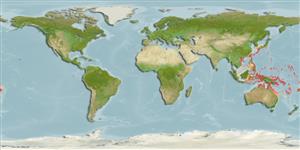>
Gobiiformes (Gobies) >
Gobiidae (Gobies) > Gobiinae
Etymology: Amblygobius: Greek, amblys = darkness + Latin gobius = gudgeon (Ref. 45335); cheraphilus: Name from Greek 'cheraphilus' meaning 'mud-loving'; referrng to its mud and silt
habitat..
Environment: milieu / climate zone / depth range / distribution range
Ecología
marino asociado a arrecife; rango de profundidad 6 - 14 m (Ref. 114936). Tropical
Distribución
Países | Áreas FAO | Ecosistemas | Ocurrencias, apariciones | Point map | Introducciones | Faunafri
Western Pacific: Papua New Guinea; Japan (Ryukyu Is.), Indonesia (Bali and Flores), Micronesia (Yap), but probably ranges widely in the East Indian Ocean.
Tamaño / Peso / Age
Maturity: Lm ? range ? - ? cm
Max length : 2.7 cm SL macho / no sexado; (Ref. 114936); 3.3 cm SL (female)
Short description
Morfología | Morfometría
Espinas dorsales (total): 7; Radios blandos dorsales (total): 13-14; Espinas anales 1; Radios blandos anales: 13 - 14; Vértebra: 26. This species is distinguished by the following characters: D VI + I,13-14; A I,13-14; caudal fin moderately lanceolate, in adults slightly longer than head length; longitudinal scales 56-60; transverse scales 15-17; body scales are entirely cycloid; scaleless on head except side of nape with 14-18 rows of cycloid scales; color when alive grayish with two dark reddish-brown stripes on head and body; the upper stripe across snout, through mid-eye, ending below middle of soft dorsal fin, while the lower stripe from rear maxilla to middle base of caudal fin with portion on opercle containing a prominent oval dark-brown spot (usually larger than pupil) and stripe ending in a prominent triangular dark brown spot on caudal-fin base; small brown saddles along the back and across predorsal region; small (slightly less than pupil size) ocellus on the upper rays of caudal fin (Ref. 114936).
Life cycle and mating behavior
Madurez | Reproducción | Puesta | Huevos | Fecundidad | Larva
Allen, G.R. and M.V. Erdmann, 2016. Descriptions of two new gobies (Gobiidae: Amblygobius) from the tropical western Pacific Ocean. J. Ocean Sci. Found. 24:10-23. (Ref. 114936)
IUCN Red List Status (Ref. 130435)
Threat to humans
Harmless
Human uses
Más información
PaísesÁreas FAOEcosistemasOcurrencias, aparicionesIntroduccionesStocksEcologíaDietacomponentes alimenticiosconsumo de alimentoRación
Nombres comunesSinónimosMetabolismoDespredadoresEcotoxicologíaReproducciónMadurezPuestaAgregación para la puestaFecundidadHuevosEgg development
Age/SizeCrecimientoLength-weightLength-lengthLength-frequenciesMorfometríaMorfologíaLarvaDinámica larvariaReclutamientoAbundanciaBRUVS
ReferenciasAcuiculturaPerfil de acuiculturaRazasGenéticaElectrophoresesheritabilidadEnfermedadesProcesamientoNutrientsMass conversion
ColaboradoresImágenesStamps, Coins Misc.SonidosCiguateraVelocidadTipo de nataciónSuperficie branquialOtolitosCerebrosVisión
Herramientas
Special reports
Download XML
Fuentes de Internet
Estimates based on models
Phylogenetic diversity index (Ref.
82804): PD
50 = 0.5000 [Uniqueness, from 0.5 = low to 2.0 = high].
Bayesian length-weight: a=0.00708 (0.00333 - 0.01504), b=3.09 (2.92 - 3.26), in cm total length, based on LWR estimates for this (Sub)family-body shape (Ref.
93245).
Nivel trófico (Ref.
69278): 3.0 ±0.2 se; based on size and trophs of closest relatives
Resiliencia (Ref.
120179): Alto, población duplicada en un tiempo mínimo inferior a 15 meses (Preliminary K or Fecundity.).
Fishing Vulnerability (Ref.
59153): Low vulnerability (10 of 100).
